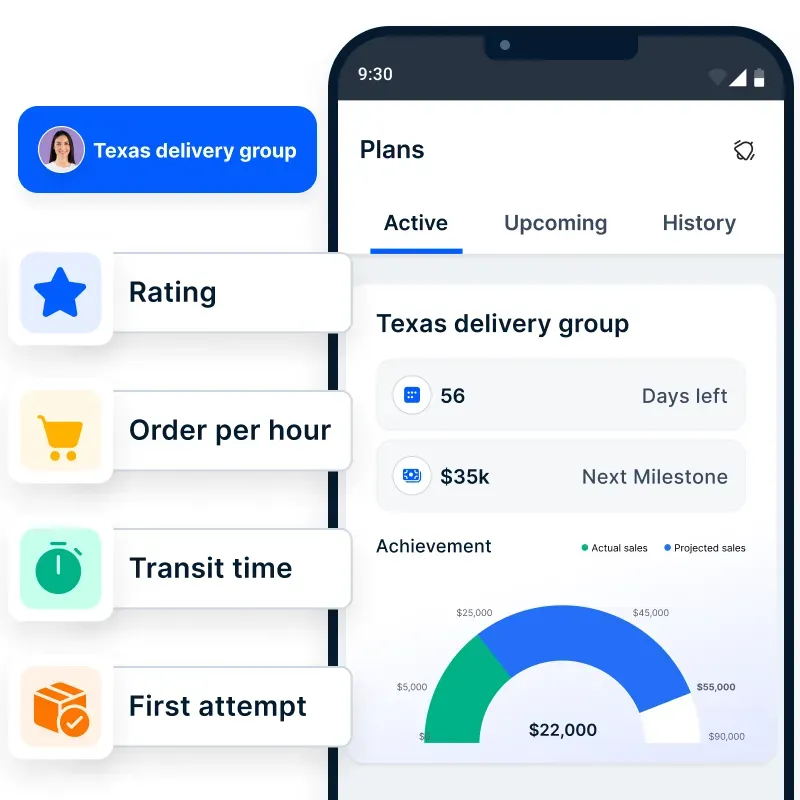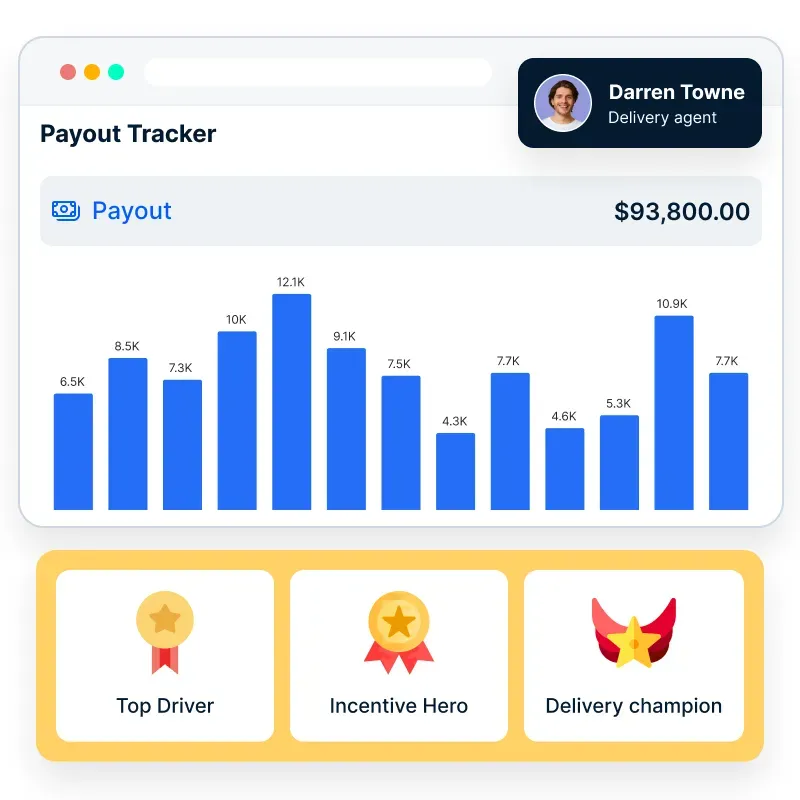Strategi Retensi Pengemudi Armada untuk Mengurangi Perputaran & Pentingnya Berinvestasi pada Armada Pengemudi Anda
Bermasalah dengan pergantian pengemudi armada? Temukan strategi praktis untuk meningkatkan retensi pengemudi armada, meningkatkan keterlibatan, dan menciptakan lingkungan kerja yang membuat pengemudi tetap berkomitmen untuk jangka panjang.

Di halaman ini
Berinvestasi pada armada pengemudi Anda adalah keputusan penting yang dapat memberikan dampak jangka panjang pada bisnis Anda. Dengan ide retensi pengemudi armada yang tepat, bisnis armada dengan berbagai ukuran dapat melibatkan dan mempertahankan pengemudi untuk jangka panjang sekaligus meningkatkan keuntungan.
Perusahaan selalu mencari pengemudi yang berkualitas. Dengan tingkat pergantian yang semakin tinggi, retensi pengemudi armada menjadi sangat penting untuk kelancaran operasional. Meskipun ada cukup banyak pengemudi di industri ini, menjaga mereka tetap terlibat dan berkomitmen tetap menjadi tantangan bagi manajer armada.
Pengemudi armada dapat meninggalkan perusahaan karena berbagai alasan, namun mempertahankan talenta terbaik sangatlah penting. Menerapkan strategi retensi pengemudi armada yang tepat akan menguntungkan perusahaan dan meningkatkan kepuasan kerja pengemudi. Sebagai manajer armada, berinvestasi pada tenaga kerja Anda memastikan Anda mempertahankan pengemudi terampil yang berkinerja secara efisien dengan tetap menjaga standar keselamatan.
Perputaran yang tinggi memang mahal, tetapi memprioritaskan retensi pengemudi armada akan menghasilkan keterlibatan yang lebih baik, produktivitas yang lebih tinggi, dan mengurangi biaya operasional. Jadi, mengapa sekarang adalah waktu yang tepat untuk fokus mempertahankan armada pengemudi Anda?
Mengapa Anda harus mempertimbangkan untuk berinvestasi dalam armada pengemudi Anda?
Departemen Transportasi A.S.NHTSA meneliti 2,2 juta kecelakaan, dan hasilnya sangat mengejutkan. Faktor lingkungan dan faktor yang berhubungan dengan kendaraan adalah penyebab dari hanya 6% kecelakaan, sementara 94% sisanya disebabkan oleh pengemudi.
Penelitian lain menemukan 9% peningkatan jumlah korban jiwa dalam kecelakaan antara tahun 2016 dan 2017 yang melibatkan truk-truk besar. Departemen Tenaga Kerja AS menemukan bahwa 40% dari kecelakaan kendaraan berhubungan dengan pekerjaan.
Penting untuk dicatat bahwa pengemudi armada lebih rentan terhadap kecelakaan karena mereka lebih sering berada di jalan daripada pengemudi biasa yang hanya ingin mengantar anak-anaknya ke sekolah dan kemudian pergi bekerja.
Kecelakaan armada tidaklah murah, tentu saja. A sebuah studi menemukan bahwa setiap kecelakaan kendaraan armada membutuhkan biaya dua kali lipat lebih besar daripada kecelakaan di tempat kerja. Hal ini karena berdampak pada hilangnya pendapatan dalam produktivitas karyawan, dan jika pengemudi yang bersalah, ada banyak implikasi, yang berarti perusahaan harus menanggung lebih banyak biaya.
Seperti yang telah disebutkan sebelumnya, sebagian besar kecelakaan terjadi karena pengemudi. Entah pengemudi terganggu, atau mereka membuat penilaian yang buruk, yang menyebabkan kecelakaan. Apa pun masalahnya, ada peluang untuk mengurangi kecelakaan, mengurangi perputaran, dan meningkatkan kemauan pengemudi untuk mengemudi secara aman dengan berinvestasi pada armada pengemudi Anda. Jika Anda melakukannya, Anda dapat mengharapkan keuntungan yang lebih tinggi dan pengemudi yang lebih bahagia.
Bagaimana hal itu bisa dicapai? Nah, gamifikasi adalah jawabannya.
Bagaimana gamifikasi membantu bisnis meningkatkan retensi pengemudi armada?
Mengemudi bukan untuk semua orang, dan mengemudi armada tentunya, bukanlah hal yang disukai setiap pengemudi. Meskipun mengemudi itu sendiri sering dianggap membosankan dan biasa, gamifikasi dapat membuatnya lebih menyenangkan dengan menambahkan elemen permainan.
Gamifikasi dapat digunakan di industri apa pun dan bagian terbaiknya adalah gamifikasi dapat diterapkan untuk meningkatkan proses internal dan eksternal. Dengan kata lain, pengguna akhir dan karyawan bisa mendapatkan manfaat darinya.
Yu-Kai Chou, pendiri Octalysis Prime dan penulis Actionable Gamification: Beyond Points, Badges, and Leaderboards, memiliki berton-ton sumber daya yang menunjukkan penggunaan gamifikasi di berbagai industri dan beragam manfaatnya.
Tapi bagaimana dengan industri armada? Apakah gamifikasi memiliki tempat di industri armada, dan dapatkah gamifikasi berhasil mempertahankan pengemudi armada?
Tentu saja.
Gamifikasi adalah salah satu cara terbaik untuk meningkatkan kinerja pengemudi armada dan mempertahankan pengemudi armada yang berkualitas. Hal ini dapat memberikan manfaat jangka panjang bagi perusahaan armada dan pengemudi armada. Berikut ini adalah beberapa manfaat signifikan dari gamifikasi dan bagaimana penerapannya pada industri armada. Gamifikasi dapat membantu meningkatkan retensi dan kinerja pengemudi.
1. Gamifikasi meningkatkan keterlibatan
Salah satu masalah yang dihadapi pengemudi armada adalah kurangnya tantangan dan perasaan bahwa mereka sendirian. Gamifikasi dapat meningkatkan keterlibatan dalam industri armada dan meningkatkan produktivitas. Gamifikasi melibatkan beberapa tujuan dan tugas yang harus diselesaikan oleh pengemudi armada.
Seperti halnya dalam sebuah permainan, jika pengemudi armada ingin naik ke level yang lebih tinggi dalam 'permainan', mereka harus menyelesaikan tugas pertama dan baru bisa membuka tujuan yang lebih tinggi. Jenis keterlibatan seperti ini mendorong pengemudi armada untuk menjadi lebih baik dalam pekerjaan mereka dan memungkinkan mereka untuk membuka potensi mereka karena mereka tahu bahwa pencapaian mereka dapat membantu mereka mendapatkan hadiah.
2. Gamifikasi mendorong persaingan yang sehat
Sudah menjadi naluri manusia untuk menjadi kompetitif dan gamifikasi memanfaatkan hal itu. Dalam industri armada, Anda bisa menggunakan gamifikasi untuk mendorong persaingan yang sehat di antara para pengemudi armada.
Misalnya, dengan menggunakan papan peringkat, Anda dapat memungkinkan pengemudi armada Anda untuk melihat siapa yang berkinerja terbaik pada saat tertentu. Ketika pengemudi melihat di mana peringkat mereka, mereka akan cenderung melakukan perubahan sehingga mereka dapat mencapai tujuan dan peringkat yang lebih tinggi di papan peringkat.
Jenis kompetisi yang sehat ini, membuat bola bergulir karena semua pengemudi armada ingin mendapatkan posisi teratas. Mekanisme motivasi ini bekerja dengan menggunakan penguatan positif yang telah terbukti lebih efektif daripada penguatan negatif.
3. Gamifikasi mendorong kolaborasi
Anda bisa mengadakan kompetisi mingguan atau bulanan antar tim. Daripada membuat pengemudi armada merasa seperti sendirian, gamifikasi dapat membuat mereka merasa menjadi bagian dari komunitas dan tim.
Misalnya, pengemudi armada di satu wilayah dapat bersaing dengan pengemudi armada di wilayah lain. Hal ini dapat memungkinkan orang-orang dalam tim yang sama untuk bekerja sama untuk mencapai tujuan dan menuai hasil bersama. Hal ini dapat meningkatkan kolaborasi dan kerja sama tim.
Hal ini sangat membantu bagi pengemudi armada yang memiliki kontak minimal dengan orang lain di perusahaan armada Anda dan memungkinkan mereka untuk bekerja sebagai sebuah tim. Hal ini menciptakan budaya kerja yang baik di mana pengemudi armada Anda dapat berprestasi tanpa adanya racun.
4. Gamifikasi mendorong perubahan perilaku
Penelitian menunjukkan bahwa pelatihan gamifikasi akan tetap melekat di benak setelah pelatihan selesai, sehingga apa yang orang pelajari dalam pengalaman gamifikasi akan bertahan lama.
Untuk pengemudi armada, gamifikasi dapat membantu mendorong perilaku yang baik seperti melakukan tindakan pencegahan keselamatan seperti tetap berada dalam batas kecepatan dan menghindari gangguan saat mengemudi. Hal ini dapat membantu bisnis Anda mengurangi biaya karena tingkat tabrakan kendaraan akan berkurang dan Anda akan menghemat banyak biaya yang terkait dengannya.
Penghargaan yang terkait dengan gamifikasi memungkinkan pengemudi armada merasa diakui dan dihargai. Hal ini dapat meningkatkan loyalitas karena pengemudi armada merasa dihargai.
5. Gamifikasi memberikan umpan balik instan
Umpan balik instan sangat penting dan gamifikasi memungkinkan pengemudi armada untuk mengetahui kapan mereka keluar dari jalur. Gamifikasi melibatkan penayangan kemajuan yang memungkinkan pengemudi armada untuk mengetahui berapa banyak tugas yang harus diselesaikan dan berapa banyak tujuan yang harus mereka capai.
Dengan bantuan data real-time, pengemudi armada mengetahui apa yang perlu dilakukan secara instan dan dapat membuat perubahan dengan cepat. Hal ini dapat membantu mereka merasa diberdayakan dan lebih percaya diri.
Perasaan nyaman secara keseluruhan dapat membantu pengemudi armada merasa nyaman dengan pekerjaan mereka dan merasa puas. Hal ini dapat meningkatkan produktivitas secara signifikan dan memungkinkan pengemudi Anda untuk mengemudi dengan kemampuan terbaik mereka.
6. Gamifikasi memungkinkan intervensi tepat waktu
Manajer armada dapat memperoleh wawasan tentang bagaimana kinerja pengemudi armada mereka di setiap titik. Anda tidak perlu menunggu hingga terjadi sesuatu yang besar, seperti kecelakaan, untuk mengetahui apa yang salah. T
elalui gamifikasi, Anda dapat mengetahui apa yang terjadi secara real time dan dapat melakukan sesuatu secara instan. Anda memiliki berbagai cara untuk mengukur kinerja pengemudi armada Anda. Hal ini dapat membantu menciptakan komunikasi yang terbuka antara Anda dan pengemudi armada Anda, sehingga menghilangkan permusuhan.
Dengan cara ini, pengemudi armada merasa terinspirasi untuk memperbaiki diri dan kecil kemungkinannya untuk mengulangi kesalahan yang sama.
7. Gamifikasi memastikan kepatuhan
Gamifikasi dapat digunakan untuk mematuhi kebijakan, aturan, dan instruksi keselamatan umum perusahaan. Karena gamifikasi melibatkan penggunanya, dalam hal ini pengemudi armada Anda, lebih banyak karyawan Anda yang akan mengikuti peraturan dan patuh karena mereka ingin 'menang'.
Karena gamifikasi dapat membuat ketagihan, karena rasa terburu-buru yang dirasakan pengguna saat mereka terus meraih hadiah setelah mencapai tujuan, mereka cenderung terus berperilaku patuh setiap hari bahkan tanpa menyadarinya.
Jenis perilaku patuh yang membuat ketagihan ini dapat membantu Anda menuai manfaat jangka pendek dan jangka panjang dalam armada Anda. Gamifikasi memungkinkan kepatuhan yang lebih baik.
8. Gamifikasi dapat membuat pembelajaran menjadi menyenangkan
Untuk pengemudi armada baru, gamifikasi dapat membantu menciptakan rasa penasaran dan membantu mereka menjadi pembelajar yang lebih baik. Pelatihan menggunakan gamifikasi dapat membuatnya lebih menyenangkan, dan pengemudi armada akan lebih mungkin menyelesaikannya.
Ambil contoh Walmart, yang menggunakan gamifikasi untuk pelatihan keselamatan. Dalam waktu dua tahun, mereka berhasil meningkatkan keselamatan di semua pusat distribusinya. Dilaporkan terjadi 54% penurunan insiden. Contoh lainnya adalah Deloitte, yang menggunakan prinsip-prinsip gamifikasi dalam Pelatihan Akademi Kepemimpinan Deloitte.
Strategi retensi pengemudi armada berbasis gamifikasi untuk mengurangi pergantian pengemudi
Strategi retensi pengemudi armada berbasis gamifikasi mengubah tugas-tugas rutin menjadi tantangan yang menarik, sehingga pekerjaan menjadi lebih bermanfaat dan didorong oleh kinerja. Dengan memasukkan papan peringkat, lencana prestasi, dan penghargaan waktu nyata, manajer armada dapat meningkatkan motivasi, mendorong persaingan yang sehat, dan menjaga pengemudi tetap berkomitmen untuk jangka panjang.
Berikut ini adalah 10 cara kreatif untuk membuat pengemudi armada Anda tetap senang, termotivasi, dan berkomitmen untuk jangka panjang:
1. Membuat pengalaman berkendara menjadi lebih menyenangkan
Siapa bilang mengemudi tidak bisa menyenangkan? Menambahkan elemen gamifikasi seperti papan peringkat, lencana pencapaian, dan penghargaan berbasis kinerja dapat mengubah tugas sehari-hari menjadi tantangan yang menarik. Ketika pengemudi melihat nama mereka naik peringkat karena mengemudi dengan aman, efisiensi bahan bakar, atau pengiriman tepat waktu, hal ini akan mendorong motivasi mereka untuk bekerja lebih baik. Sedikit kompetisi yang bersahabat dapat meningkatkan semangat dan keterlibatan.
Berikan insentif kepada karyawan yang berprestasi dengan imbalan seperti bonus, cuti ekstra, atau fasilitas eksklusif, dan lihatlah bagaimana motivasi mereka meningkat. Gamifikasi tidak hanya membuat pekerjaan menjadi menyenangkan, namun juga menciptakan rasa pencapaian dan pengakuan yang membuat para pengemudi tetap berinvestasi dalam peran mereka.
Dengan memanfaatkan Compass, manajer armada dapat mengotomatiskan penghargaan, memberikan pengakuan secara instan, dan menciptakan budaya peningkatan berkelanjutan. Gamifikasi tidak hanya meningkatkan keterlibatan, tetapi juga mendorong persaingan yang sehat dan membuat pengemudi tetap berinvestasi dalam pekerjaan mereka.
2. Kesempatan belajar yang berkelanjutan
Pengemudi ingin berkembang, tidak hanya berpindah dari satu pengiriman ke pengiriman lainnya. Menawarkan program pelatihan, lokakarya, dan sertifikasi di berbagai bidang seperti keterampilan mengemudi tingkat lanjut, pemeliharaan kendaraan, dan kepemimpinan memberi mereka rasa kemajuan dalam karier mereka.
Pertimbangkan untuk memberikan akses ke kursus khusus dalam manajemen logistik, koordinasi armada, atau bahkan teknologi yang sedang berkembang seperti pelacakan armada bertenaga AI. Ketika pengemudi melihat jalur yang jelas untuk kemajuan karier, mereka cenderung bertahan untuk jangka panjang.
3. Penjadwalan yang fleksibel untuk keseimbangan kehidupan kerja
Kelelahan adalah salah satu alasan terbesar pengemudi berhenti. Jam kerja yang panjang, jadwal yang tidak dapat diprediksi, dan beban kerja yang berlebihan dapat mendorong pengemudi yang paling berdedikasi sekalipun untuk mencari peluang yang lebih baik. Menyediakan opsi penjadwalan yang fleksibel memastikan pengemudi dapat menjaga keseimbangan kehidupan kerja yang sehat, mengurangi stres dan kelelahan.
Tawarkan shift yang dapat diprediksi, jadwal rotasi, atau bahkan hak untuk memilih rute mereka. Perusahaan yang memprioritaskan kesejahteraan pengemudi akan mendapatkan kesetiaan dan komitmen dari mereka.
4. Program insentif yang dipersonalisasi
Pendekatan satu ukuran untuk semua tidak akan berhasil dalam hal motivasi. Tidak semua pengemudi terdorong oleh insentif yang sama, sehingga menawarkan imbalan yang dipersonalisasi akan memberikan dampak yang nyata. Beberapa orang mungkin lebih menyukai bonus uang, sementara yang lain mungkin lebih menyukai hari libur ekstra, voucher bahan bakar, atau tunjangan kesehatan.
Biarkan pengemudi memilih hadiah mereka berdasarkan apa yang paling penting bagi mereka. Perubahan sederhana ini membuat insentif menjadi lebih bermakna dan memperkuat hubungan mereka dengan perusahaan. Ketika karyawan merasa bahwa kebutuhan pribadi mereka diperhatikan, mereka akan lebih mungkin untuk tetap terlibat dan berkomitmen.
Dengan menyelaraskan imbalan dengan metrik kinerja seperti mengemudi dengan aman, pengiriman tepat waktu, atau konsumsi bahan bakar yang rendah, Compass memastikan pengemudi merasa dihargai dan termotivasi. Sistem yang mengakui dan menghargai upaya membuat karyawan tetap terlibat, membuat mereka lebih mungkin untuk tetap bersama perusahaan dalam jangka panjang.
5. Teknologi canggih untuk pengalaman yang lebih lancar
Peralatan yang sudah ketinggalan zaman dan proses yang tidak efisien dapat membuat pengemudi frustasi dan mempersulit pekerjaan mereka. Berinvestasi dalam teknologi armada modern-seperti navigasi GPS, pemantauan efisiensi bahan bakar, pelacakan waktu nyata, dan alat manajemen armada bertenaga AI-membantu pengemudi bekerja lebih cerdas, bukan lebih keras.
Menyediakan kendaraan yang terawat dengan baik dan nyaman dengan fitur keselamatan terbaru juga meningkatkan pengalaman berkendara. Ketika pengemudi memiliki alat yang tepat yang dapat mereka gunakan, mereka merasa lebih didukung dan tidak terlalu tertekan, sehingga membuat mereka lebih mungkin untuk bertahan dengan perusahaan.
6. Komunikasi yang terbuka dan transparan
Pengemudi sering kali merasa tidak terhubung dengan manajemen, sehingga menimbulkan ketidakpuasan dan ketidakterlibatan. Membangun saluran komunikasi yang jelas akan membantu mereka merasa didengar, dihargai, dan dilibatkan.
Buatlah lingkaran umpan balik yang teratur di mana pengemudi dapat berbagi kekhawatiran, ide, dan saran. Gunakan alat bantu seperti survei anonim, saluran khusus dukungan pengemudi, atau check-in satu per satu untuk memastikan adanya dialog yang terbuka. Ketika pengemudi melihat bahwa masukan mereka berarti, mereka akan membangun hubungan yang lebih kuat dengan perusahaan.
7. Dukungan kesehatan dan kesehatan mental
Mengemudi itu berat, baik secara fisik maupun mental. Perusahaan yang memprioritaskan kesejahteraan pengemudi akan menjadi perusahaan pilihan. Menerapkan prakarsa kesehatan seperti:
- Program kesehatan dan kebugaran (keanggotaan gym, tantangan kesehatan)
- Dukungan kesehatan mental (layanan konseling, lokakarya manajemen stres)
- Program manajemen kelelahan (edukasi kebersihan tidur, istirahat terstruktur)
Pengemudi yang merasa didukung secara fisik dan mental akan lebih mungkin untuk tetap terlibat dan produktif.
8. Pengakuan dan penghargaan publik
Ucapan "terima kasih" yang sederhana bisa sangat berarti. Mengakui dan mengapresiasi pengemudi secara terbuka dapat meningkatkan semangat kerja dan memperkuat loyalitas. Rayakan pencapaian seperti:
- Peringatan tahun-tahun masa kerja
- Catatan mengemudi yang aman
- Pujian pelanggan dan umpan balik positif
Pengakuan dapat berupa pujian di buletin perusahaan, fitur media sosial, bonus, atau penghargaan khusus. Semakin dihargai, semakin besar komitmen mereka untuk tetap bersama perusahaan.
Dengan Alat manajemen insentif penjualan dariCompassperusahaan dapat membuat program penghargaan terstruktur yang merayakan pengemudi berprestasi dengan bonus, lencana prestasi, dan penghargaan berbasis pencapaian. Dengan memastikan pengakuan yang adil dan tepat waktu, Compass membantu membangun budaya tempat kerja di mana para pengemudi merasa dihargai, termotivasi, dan berkomitmen untuk jangka panjang.
9. Ikatan tim dan pembangunan komunitas
Pengemudi sering kali bekerja sendirian, sehingga sulit untuk merasakan semangat tim. Mengadakan acara pembangunan tim, pertemuan sosial, atau pertemuan perusahaan membantu membangun hubungan di antara para pengemudi dan menumbuhkan rasa saling memiliki.
Adakan pertemuan tahunan, acara barbekyu, acara apresiasi pengemudi virtual, atau bahkan program bimbingan pengemudi di mana pengemudi yang sudah berpengalaman dapat membantu pengemudi yang baru bergabung. Rasa kebersamaan yang kuat dapat membuat pekerjaan terasa lebih dari sekadar pekerjaan-ini menjadi bagian dari sesuatu yang lebih besar.
10. Jalur peningkatan karier yang jelas
Pengemudi perlu melihat masa depan di luar kursi pengemudi. Menawarkan peluang pengembangan karier yang jelas akan membantu mereka membayangkan karier jangka panjang bersama perusahaan. Sediakan jalur yang jelas untuk pindah ke manajemen armada, koordinasi logistik, peran pelatihan, atau posisi penyelia.
Dengan mempromosikan dari dalam dan berinvestasi dalam pengembangan kepemimpinan, perusahaan menunjukkan bahwa mereka menghargai kontribusi pengemudi mereka lebih dari sekadar mengemudi. Ketika karyawan melihat potensi untuk berkembang, mereka akan bertahan lebih lama dan tetap terlibat dalam pekerjaan mereka.
Retensi pengemudi armada bukan hanya tentang menawarkan gaji yang lebih tinggi-ini adalah tentang menciptakan lingkungan kerja yang positif di mana pengemudi merasa dihargai, didengar, dan termotivasi. Dengan membuat pengalaman yang menyenangkan, menawarkan jadwal yang fleksibel, berinvestasi dalam pelatihan, dan memberikan penghargaan atas pencapaian, perusahaan dapat mengurangi tingkat perputaran karyawan dan membangun tenaga kerja yang berdedikasi dan berkinerja tinggi.
Retensi dimulai dengan keterlibatan-bagaimana Anda akan membuat pengemudi Anda tetap termotivasi?
Memperkuat retensi pengemudi armada dengan insentif inovatif dan analitik real-time
Mempertahankan pengemudi armada membutuhkan lebih dari sekadar gaji yang kompetitif-ini membutuhkan strategi yang terstruktur dengan baik yang membuat mereka tetap terlibat, termotivasi, dan selaras dengan tujuan bisnis. Compass membantu manajer armada menerapkan strategi retensi berbasis datauntuk memastikan pengemudi tetap berkomitmen sekaligus meningkatkan efisiensi operasional secara keseluruhan.
Dasbor kinerja yang dipersonalisasi

Pengemudi sering kali keluar karena kurangnya kejelasan tentang kemajuan dan insentif mereka. Compass menyediakan dasbor kinerja real-time yang memberikan visibilitas kepada pengemudi ke dalam metrik kinerja utama mereka, potensi penghasilan, dan area untuk perbaikan, membuat mereka tetap termotivasi dan terlibat.
Transparansi insentif untuk motivasi yang lebih tinggi
Ketidakpastian mengenai upah dan insentif merupakan alasan yang signifikan untuk pergantian pengemudi. Compass menawarkan kalkulator penghasilan yang memungkinkan pengemudi untuk melihat potensi penghasilan mereka sebelum melakukan pengantaran. Hal ini memastikan kompensasi yang adil, mendorong kinerja yang lebih tinggi, dan membangun kepercayaan antara pengemudi dan manajemen.
Gamifikasi yang didukung oleh AI untuk meningkatkan keterlibatan

Keterlibatan pengemudi sangat penting untuk retensi jangka panjang. Compass mengintegrasikan papan peringkat, kartu skor, dan tantangan khusus untuk mengubah pelacakan kinerja menjadi pengalaman yang menarik. Mengakui dan memberi penghargaan kepada pengemudi yang berkinerja terbaik akan menumbuhkan rasa pencapaian dan mendorong peningkatan yang berkelanjutan.
Metrik khusus untuk tim yang beragam
Setiap armada beroperasi secara berbeda, dan tidak semua pengemudi merespons ekspektasi yang sama. Compass memungkinkan perusahaan untuk menyesuaikan parameter kinerja berdasarkan keterampilan individu dan kebutuhan operasional, memastikan pendekatan yang adil dan sesuai untuk manajemen kinerja.
Dengan memanfaatkan Compass, manajer armada dapat meningkatkan retensi pengemudi, mengurangi pergantian pengemudi, dan menciptakan budaya berbasis kinerja di mana pengemudi merasa dihargai dan termotivasi untuk tetap tinggal.
Kesimpulan
Gamifikasi dengan sendirinya memiliki potensi untuk mengubah kinerja pengemudi armada Anda. Jika diatur dengan benar dengan alat seperti Compass, Anda dapat mempertahankan pengemudi armada terbaik yang akan lebih bersedia untuk tinggal dan bekerja untuk Anda.
Dengan menggunakan elemen gamifikasi dalam armada, pengemudi akan termotivasi untuk bekerja keras dan memperhatikan pekerjaan mereka sehingga mereka mengikuti langkah-langkah keselamatan dan mematuhi peraturan perusahaan. Gamifikasi dapat membantu manajer armada mendapatkan yang terbaik dari pengemudi mereka sekaligus memangkas biaya dan memiliki tenaga kerja pengemudi yang produktif.






